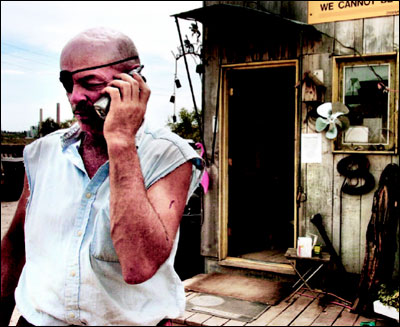 A part of the environmental debate that hasn’t gotten a lot of attention made the pages of the March 2009 issue of Consumer Reports and it’s sure to raise some eyebrows. The offender? Interior paint.
A part of the environmental debate that hasn’t gotten a lot of attention made the pages of the March 2009 issue of Consumer Reports and it’s sure to raise some eyebrows. The offender? Interior paint.
A moment of pause should occur before you decide you head to the store and start thinking about changing the color of their dwelling’s walls. According to eartheasy.com, “indoor air is three times more polluted than outdoor air, and according to the [U.S. Environmental Protection Agency (EPA)], is considered to be one of the top-five hazards to human health. Paints and finishes are among the leading causes.”
The offending toxin in paints are called Volatile Organic Compounds (VOCs), organic chemical compounds that have high enough vapor pressures under normal conditions to significantly vaporize and enter the atmosphere. The EPA lists possible symptoms as eye, nose, and throat irritation; headaches, loss of coordination, nausea; damage to liver, kidney, and central nervous system.
According to the Consumer Reports article, federal VOC limits are now set at 250 grams per liter (g/l) for flat paints and 380 g/l for others. California, with its uber-green focus, has stricter standards: 150 g/l for nonflat finishes and 100 g/l for others. Around Los Angeles, California’s South Coast Air Quality Management district is even tougher with a 50 g/l level for all finishes.
How do you check on a paint before starting that project? Look for one of three “green-certification labels” that might aid your search:
- Green Seal: Founded in 1989, Green Seal provides science-based environmental certification standards that are credible, transparent, and essential in an increasingly educated and competitive marketplace. Its industry knowledge and standards help manufacturers, purchasers, and end users alike make responsible choices that positively impact business behavior and improve quality of life. The organization is based in Washington, D.C.
- GreenGuard: As an ANSI Authorized Standards Developer, GreenGuard Environmental Institute (GEI) establishes acceptable indoor air standards for indoor products, environments, and buildings. GEI’s mission is to improve public health and quality of life through programs that improve indoor air. An advisory board consisting of independent volunteers, who are renowned experts in the areas of indoor air quality, public and environmental health, building design and construction, and public policy, provides guidance and leadership to GEI. The organization is based in Marietta, Ga.
- GreenSure: A self-regulated designation by paint giant Sherwin Williams, the company takes a very strict approach to VOC levels by capping it at 50 g/l through its four green-friendly products. Sherwin Williams, founded in 1866.
Photo credit: Caitlin Burke via a Creative Commons license on Flickr



The dangers of Volatile Organic Compounds (VOCs) in paint have been known for a long time, but it’s a topic that still gets little play in the quest for cleaner air and a healthier life.
While we concentrate our efforts on the outside world, we would be best served by starting with a review of the products inside our four walls.
The dangers of Volatile Organic Compounds (VOCs) in paint have been known for a long time, but it’s a topic that still gets little play in the quest for cleaner air and a healthier life.
While we concentrate our efforts on the outside world, we would be best served by starting with a review of the products inside our four walls.
Indoor air quality is hugely important, but some “protective” organizations are not all they claim to be.
Greenguard is ANSI accredited to develop standards and has a board of people to review them, yet none of their VOC standards have used their ANSI approved process, none have been reviewed by their board, and so none are ANSI approved standards.
Greenguard’s partner test business, Air Quality Sciences, wrote the Greenguard standards, mixing ASHRAE ventilation criteria for offices, or in some cases the CDHS “section 01350” ventilation criteria for schools, with a variety of VOC concentration limits in air. These are NOT representative of homes, which often have much lower ventilation rates.
For a well written critique, with a response from Greenguard, see: https://www.blogger.com/comment.g?blogID=35310021&postID=931719465537750145 or simply google “greenguard false claims”.
Greenguard has certified many products and they do require testing, but all details of their standards are not public. The more products they certify the more money their partner business can make from the ongoing testing.
See: http://www.treehugger.com/files/2009/01/sherwin-williams-greensure.php
Indoor air quality is hugely important, but some “protective” organizations are not all they claim to be.
Greenguard is ANSI accredited to develop standards and has a board of people to review them, yet none of their VOC standards have used their ANSI approved process, none have been reviewed by their board, and so none are ANSI approved standards.
Greenguard’s partner test business, Air Quality Sciences, wrote the Greenguard standards, mixing ASHRAE ventilation criteria for offices, or in some cases the CDHS “section 01350” ventilation criteria for schools, with a variety of VOC concentration limits in air. These are NOT representative of homes, which often have much lower ventilation rates.
For a well written critique, with a response from Greenguard, see: https://www.blogger.com/comment.g?blogID=35310021&postID=931719465537750145 or simply google “greenguard false claims”.
Greenguard has certified many products and they do require testing, but all details of their standards are not public. The more products they certify the more money their partner business can make from the ongoing testing.
See: http://www.treehugger.com/files/2009/01/sherwin-williams-greensure.php
Thanks for the tips on this. It’s good to know what the different certifications mean–and to help out our readers at SuperEco, I wrote an article referencing this one about the certifications.
It’s at http://www.supereco.com/news/2009/02/05/putting-the-non-toxic-seal-on-paint/
Cheers,
Alex
Thanks for the tips on this. It’s good to know what the different certifications mean–and to help out our readers at SuperEco, I wrote an article referencing this one about the certifications.
It’s at http://www.supereco.com/news/2009/02/05/putting-the-non-toxic-seal-on-paint/
Cheers,
Alex
Benjamin moore has a brand of paint called natura that’s supposedly good for the environment.
Benjamin moore has a brand of paint called natura that’s supposedly good for the environment.
Check out Amazon Select paint. It is at least 95% recycled, and therefore saves all the energy that goes into making new paint. It carries the Green Seal stamp of approval.
It is available at Ace Hardware stores in Minnesota, as well as factory-direct in Riverside, CA, Fridley, MN, and Pryor, OK.
Check out Amazon Select paint. It is at least 95% recycled, and therefore saves all the energy that goes into making new paint. It carries the Green Seal stamp of approval.
It is available at Ace Hardware stores in Minnesota, as well as factory-direct in Riverside, CA, Fridley, MN, and Pryor, OK.